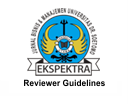THE EFFECT OF FINANCIAL PERFORMANCE ON LQ45 SHARE RETURN IN INDONESIA STOCK EXCHANGE
 Abstract views: 222
,
Abstract views: 222
,
 PDF downloads: 225
PDF downloads: 225
Abstract
This research was conducted with the aim to find out and analyze the effect of simultaneous return on assets, return on equity, debt to equity ratio, debt to assets ratio, earnings per share, and price earning ratio on LQ45 stock returns on the Indonesia Stock Exchange. This study uses a quantitative approach. Based on the porposive sampling technique, the companies that met the research criteria were 17 LQ45 companies on the Indonesia Stock Exchange. The data used are financial statements for the period 2015-2017. Data analysis techniques are using multiple linear regression, F test, and t test.
Based on the results of the study note that simultaneous return on assets, return on equity, debt to equity ratio, debt to assets ratio, earnings per share, and price earnings ratio does not affect stock returns, this is evidenced by the results of testing with the F test that shows the significance value is greater than 0.05 which is equal to 0.187. Return On Assets does not have a significant effect on stock returns because the significance value of the t test is greater than 0.05 which is 0.767. Return On Equity does not have a significant effect on stock returns because the significance value of the t test is greater than 0.05 which is equal to 0.489. Debt to Equity Ratio has no significant effect on stock returns because the significance value of the t test is greater than 0.05 which is equal to 0.935. Debt to Assets Ratio does not have a significant effect on stock returns because the significance value of the t test is greater than 0.05 which is 0.593. Earning Per Share has a significant effect on stock returns because the significance value of the t test is greater than 0.05 which is equal to 0.025. Price Earning Ratio has no significant effect on stock returns because the significance value of the t test is greater than 0.05 which is equal to 0.336.
References
Darmadi, Hamid. 2011. Metode Penelitian Pendidikan. Bandung: Penerbit Alfabeta.
Darmadji, T and Fakhruddin, H.M. 2015. Pasar Modal Indonesia, Pendekatan Tanya Jawab. Jakarta: Salemba Empat.
Fahmi, Irham. 2013. Analisis Laporan Keuangan. Bandung: Alfabeta.
Hanafi, Mamduh and Abdul Halim. 2012. Analisis Laporan Keuangan. Cetakan Pertama. Yogyakarta: UPP-AMP YKPN.
Hery. 2015. Analisa Laporan Keuangan Pendekatan Rasio Keuangan. Jakarta: PT. Buku Seru.
Jumingan. 2014. Analisa Laporan Keuangan. Jakarta: Bumi Aksara.
Rahmawati, Windy Dwi. 2018. Pengaruh Return On Asset, Debt To Equity Ratio, Current Ratio, Dan Earning Per Share Terhadap Return Saham Pada Perusahaan Sektor Industri Barang Konsumsi Yang Terdaftar Di Bursa Efek Indonesia Periode 2015-2017. Artikel Skripsi. Universitas Nusantara PGRI Kediri. Hal: 1-9.
Sartono, Agus. 2010. Manajemen Keuangan Teori dan Aplikasinya. Yogyakarta: BPFE.
Sarwono, Jonathan. 2011. IBM SPSS Statistics 19. Jakarta: Penerbit PT. Elex Media Komputindo.
Sugiyono. 2011. Metode Penelitian Kuantitatif, Kualitatif Dan R&D. Cetakan ke-13. Bandung: Alfabeta.
Copyright (c) 2020 Ekspektra : Jurnal Bisnis dan Manajemen

This work is licensed under a Creative Commons Attribution-NonCommercial-ShareAlike 4.0 International License.
Ekspektra : Jurnal Bisnis dan Manajemenis licensed under a Creative Commons Attribution-ShareAlike 4.0 International License.























